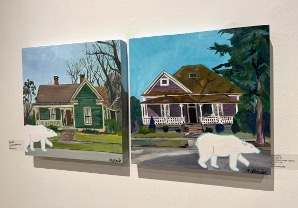by Haley Miller
The Dedo Maranville Gallery at Valdosta State University hosted the 37th Annual “Valdosta National Exhibition,” which opened on January 14th. The exhibition includes the artwork of different artists from 12 states across the U.S. Juried by Michael McFalls, a professor at Columbia State University, the show sought to find work that “captures both individual artistic excellence and a larger cultural conversation.”[1] As mentioned in the juror’s statement, artists have used their work as visual language for centuries, creating a sense of shared experiences between humanity. McFall looked for artworks that would add a new point of view or go beyond just formal proficiency. The exhibition certainly offers an array of different themes, from ones that address societal issues like the environment to more expressive works that touch on identity, spirituality, and the questioning of our common reality.[2] There are several different mediums ranging from painting, sculpture, and photography to more unique forms like miniature scenes and small sculptures.
The exhibition space is well-lit, with spotlights pointed directly at the artworks. The walls are white and each of the artworks has a good amount of space on either side, allowing them to stand out without being overshadowed by other works. In total, there are 33 artworks on display from 25 artists. Walking in the front doors of the exhibition, viewers first see a row of five artworks to the right that deal with similar formal elements, specifically line and color. Included in this group is Duchamp Invents the Wheel by Richard Yasko. Moving past, we get to some more realistic art pieces, including Moment of Devotion by AnaMarie Liddell and Barber Shop by Phil Gleason. Next, we pass by a video installation featuring an animated plane flying through the sky and rows of crop fields. After that, in the corner farthest from the entrance, there is an array of mixed media artworks and sculptures, such as Polar Walk 9 and Polar Walk 10 by Aimee Fresia, which feature a cut out polar bear wandering the streets of a suburban area. As you circle back to walk along the opposite wall, there are some works that can be interpreted as focusing on identity, like What Remains by Katherine Chudy and Sunroom for the End of the World, the winning piece by Jason Stout.

Upon first seeing Polar Walk 9 and Polar Walk 10 by Aimee Fresia, I immediately thought of all the latest news reports on the melting of the arctics, where polar bears primarily live. It seemed as though the artist’s intention was to show that global warming is destroying these polar bears’ habitats, and they will have to find somewhere new to go. Both artworks are paintings of generic homes with polar bears attached near the foreground to look as though they are walking down the street. The polar bears themselves are simple white cutouts with blue lines to indicate their shape with minimal detail, lacking any sense of depth that is seen in the background paintings. The scenes and houses themselves have an animated feel, with little depth added to the ground and sky. While Fresia’s artworks made me think about climate change, the artist’s statement reveals that she is equating herself to polar bears, as polar bears are known to spend their lives alone. She was thinking about the loneliness that comes with being an outsider, like when one lives in a new place. With Fresia moving to a new city for an artist residency, she had the opportunity to work in solitude, where she is “that polar bear in Newnan, walking the streets unseen.” In my opinion, separating the polar bears from the painted scenes effectively adds to the sense of loneliness the artist is trying to convey.

In Duchamp Invents the Wheel by Richard Yasko, there is a large bicycle wheel atop a wooden stool as the main focal point of the composition. This is a clear nod to Duchamp, who produced a sculptural readymade in the same way. Readymades are works of art made up of already existing objects, elevated to the status of art because it is classified as such. Clean, red lines surround the wheel, sprouting out to meet the edges of the artwork, almost like sun rays against a pale-yellow sky. Below are two detailed drawings of bicycles that are bordered with lettering: “I think of bicycles as rideable art that can… save the world.” The artist plays with different variations of the bicycle, one being the bicycle wheel as a readymade, and the other being more literal representations of bicycles. These different representations can lead to different interpretations of the piece. With Duchamp’s bicycle wheel seemingly represented as the sun, Yasko could be saying that Duchamp’s readymades became the center of the artworld, inspiring many future artists to rethink their assumptions of what art is and what it can be. In the artist statement, Richard Yasko adds that “viewers may carry away a spark of an idea that will allow an exploration of beliefs and contemporary situations, possibly challenging their assumed realities in the process.”[3] Yasko’s piece undoubtedly achieves this, adding to larger cultural conversations in the art world.
The 37th Valdosta National aimed to bring new perspectives to the shared experience of humanity while also encouraging viewers to question their own reality. In this respect, I would say that the exhibition was successful. For instance, the idea of being alone has been touched on by many artists, but it is such a universal experience throughout the world that it cannot be overdone. Fresia takes emotions such as this and communicates them in innovative, discreet ways, like identifying with polar bears. Yasko, on the other hand, opens discussions up to the influences of the art world, allowing viewers to question just how important Duchamp’s readymade concept is.
[1] Michael McFalls, “Juror’s Statement for the 37th Annual Valdosta National,” file:///C:/Users/mille/Downloads/EditedValdostaNational-StatementsPrices-1.pdf.
[2] Mcfalls.
[3] Richard Yasko, “Juror’s Statement for the 37th Annual Valdosta National,” file:///C:/Users/mille/Downloads/EditedValdostaNational-StatementsPrices-1.pdf.